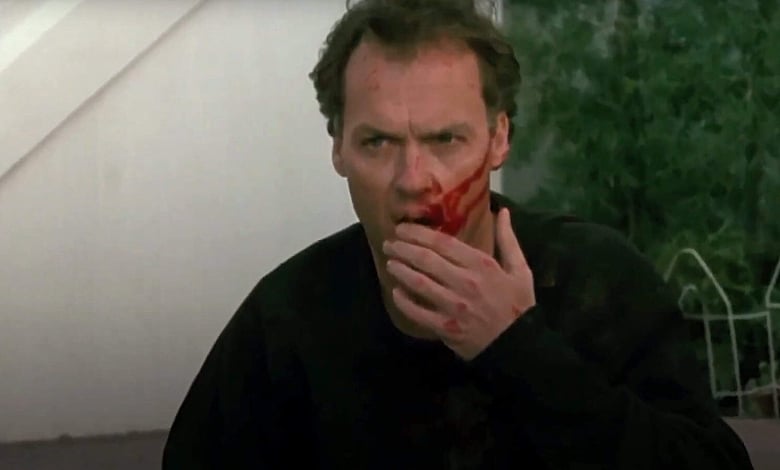
John Schlesinger’s “Pacific Heights” (1990) opens with sex and violence, showing us that anyone who meets Carter Hayes, the film’s mesmerizing villain, will either be punished, wind up one of his victims or both.
Only wreckage and heartbreak come from this man, a sociopath with a slick façade and a self-destructive streak that is somewhere between gambling and sadism. Hayes is played by Michael Keaton, showcasing his first turn as a villain, in a remarkable performance that elevates Schlesinger’s expertly crafted but pulpy thriller.
Patty and Drake, played by Melanie Griffith and Matthew Modine, buy a massive Victorian home in San Francisco’s Pacific Heights neighborhood for $750,000.00 (this is the price in 1990 – today, the home would be valued around $1.8 million).
In addition to buying the place and paying for massive renovations, Patty and Drake become the landlords.
At first, we see some nice people and a sweet family becoming their tenants. Then, Hayes enters the picture – we know he’s no good but when Drake and Patty interview him, we get why they fall for his act. Hayes seems reliable, has deep pockets and comes across like a potentially ideal tenant.
Later, when constant hammering and sawing noises come from Hayes apartment late at night, they realize they’ve made a horrible mistake.
Michael Keaton in Pacific Heights specifically pic.twitter.com/X7FN3iVewF
— Belle (@belle_aec) September 6, 2024
The busy, exciting score by Hans Zimmer pulls us in, as does the prolog that not only sets up a film noir angle but gives us Beverly D’Angelo; normally cast in comedies during this era, D’Angelo is an ideal femme fatale and like Keaton, turns out to be perfect in darker material.
Keaton did this right after “Batman” (1989) and before the nice-try failure “Extreme Measures” (1998). The villainy of Hayes is especially intriguing in that, like Keaton’s take on Bruce Wayne. The madness is internal, and we only get glimpses of it coming to the surface.
Hayes is such a mystery; it’s worth noting that the childhood photos of him out in the open may not even be of him! Hayes is like Bruce Wayne without the Batsuit, Alfred Pennyworth or a sense of duty to defend the innocent in the night.
Hayes is Wayne with only the angst and inner rot.
“Pacific Heights” is not on the level of classic late 20th-century mainstream thrillers like “The Silence of the Lambs” (1991) or “Fatal Attraction” (1987), but is akin to smaller, deviously entertaining chair grabbers like “Single White Female” (1992) and especially “Malice” (1993).
A clever touch in Daniel Pyne’s screenplay is how Drake thinks a former applicant is trying to scam him but isn’t, while Hayes’ act initially sells Drake and Patty immediately.
When “Pacific Heights” was released, some critics went after the film for presenting sympathetic landlords (!). Perhaps few have had landlords as likable as Modine and Griffith come across, though its actually refreshing to see landlords depicted as something other than in the generic fashion of being mean and unlikable.
The details that actually don’t work for me are how Patty gives horse riding lessons and Drake’s company makes kites – whimsical touches, sure, but clearly not enough to pay for their home. I guess being a landlord and getting conned by the likes of Carter Hayes was inevitable?
Modine is especially forceful here, but he and Griffith’s characters still come across as innocent and naïve. When they are informed that Hayes’ power over them in legal matters (“if he’s in, he’s got rights”), their foolishness in not vetting their potential renters better comes across.
Great character actors make up the supporting cast, starting with a terrific Laurie Metcalfe as Drake and Patty’s lawyer. Dan Hedaya and Mako have memorable parts, though the crown jewel is a great, dialog-free but pitch-perfect cameo from Tippi Hendren.
Admittedly, Roman Polanski’s” “The Tenant” (1976) is far scarier and much stranger than “Pacific Heights.” Schlesinger also includes a silly dream sequence that wasn’t needed. Yet, it never stops moving and both Hayes and Keaton’s performance gets increasingly scarier as the film races forward.
Longtime fans of Keaton need to give this one a revisit, while homeowners thinking of becoming landlords should see this as a dire warning and essential cautionary tale.
